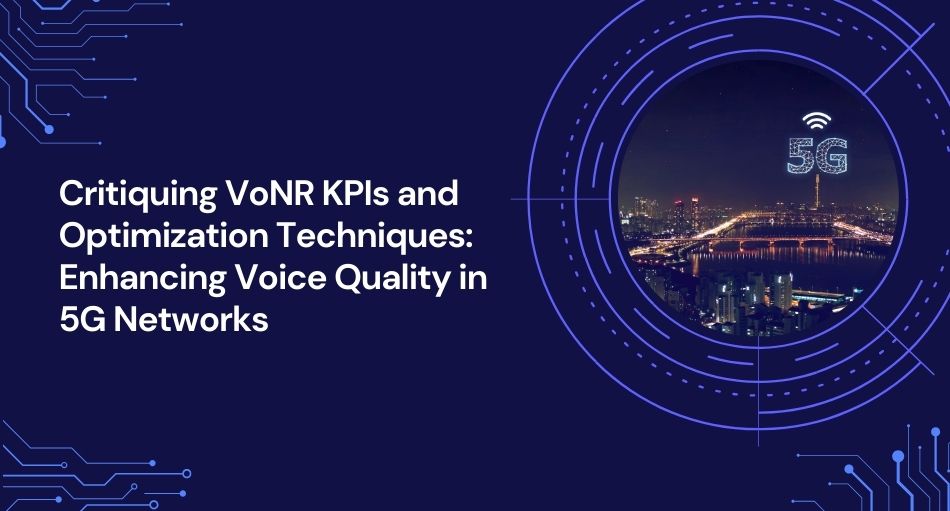Abstract
Voice over New Radio (VoNR) is poised to revolutionize voice communication in 5G networks by leveraging the capabilities of the 5G standalone (SA) architecture. As operators transition from legacy systems to VoNR, understanding and optimizing Key Performance Indicators (KPIs) becomes crucial for delivering superior voice quality. This article delves into the critical evaluation of VoNR KPIs, such as the Mean Opinion Score (MOS), and explores optimization techniques that network operators can employ to enhance user experience.
Introduction
The advent of 5G technology has brought a paradigm shift in mobile communications, offering unprecedented data speeds, ultra-low latency, and massive connectivity. Voice over New Radio (VoNR) represents the next evolution in voice services, utilizing the 5G NR air interface for voice calls instead of relying on legacy 4G LTE networks through Voice over LTE (VoLTE) or fallback mechanisms.
While VoNR promises enhanced voice quality and faster call setup times, realizing these benefits requires meticulous attention to Key Performance Indicators (KPIs) that gauge network performance and user experience. Traditional KPIs like the Mean Opinion Score (MOS) are now being scrutinized under the new dynamics of 5G networks.
This article critically examines the existing VoNR KPIs, identifies their limitations, and discusses advanced optimization techniques that network operators can adopt to improve voice quality in 5G networks.
Understanding VoNR and Its Significance
What is VoNR?
Voice over New Radio (VoNR) is a voice service that operates over the 5G standalone (SA) network, using the 5G NR air interface for both voice and data services. Unlike non-standalone (NSA) deployments, where voice services are handled by LTE networks, VoNR allows for voice calls without relying on legacy infrastructure.
Significance of VoNR in 5G Networks
- Enhanced Voice Quality: VoNR can provide higher voice quality due to better codecs and increased bandwidth.
- Reduced Latency: With 5G’s low-latency capabilities, VoNR can offer faster call setup times and reduced voice delays.
- Network Efficiency: Utilizing the 5G core for voice services streamlines network operations and reduces dependency on 4G infrastructure.
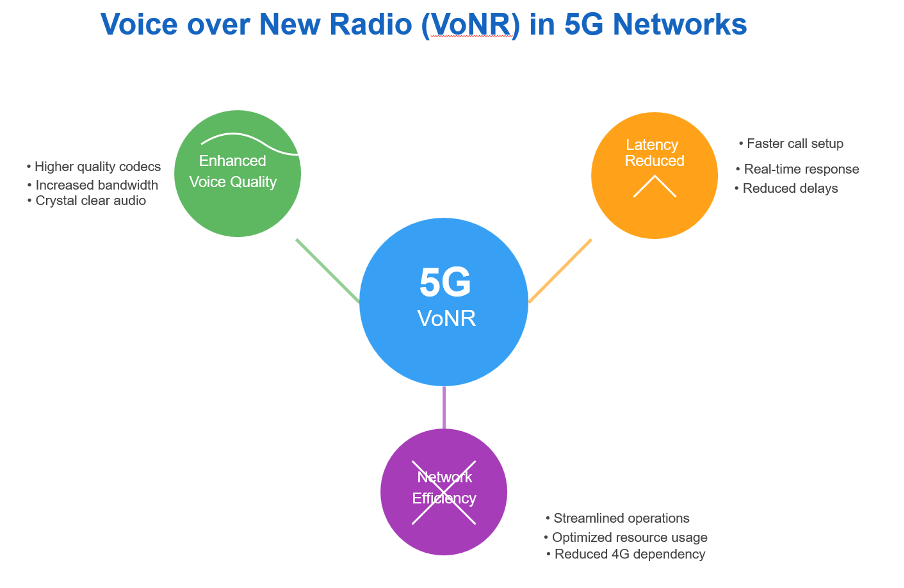
Critical Evaluation of VoNR KPIs
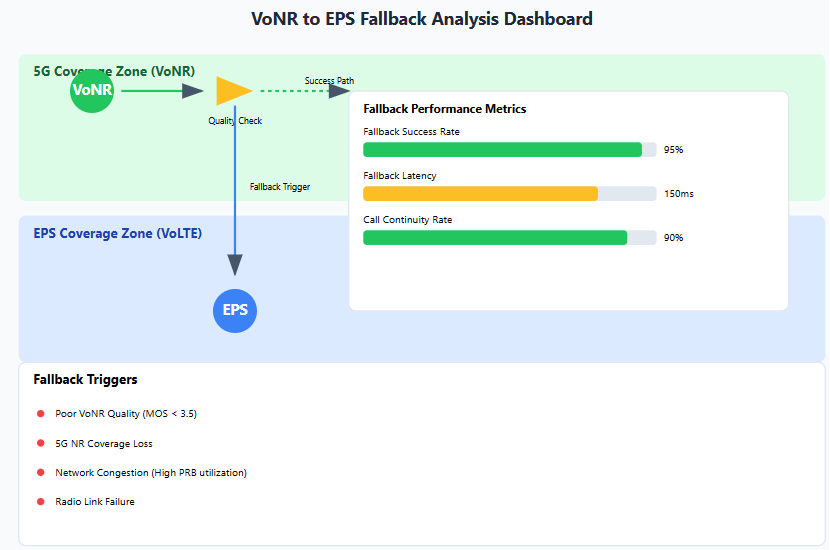
Key Performance Indicators (KPIs) are essential metrics that help network operators assess and optimize network performance. However, the transition to VoNR necessitates a reevaluation of traditional KPIs.
Mean Opinion Score (MOS)
Overview
The Mean Opinion Score (MOS) is a numerical measure of voice quality experienced by users, typically ranging from 1 (poor) to 5 (excellent). It is derived from subjective user assessments or objective algorithms like Perceptual Evaluation of Speech Quality (PESQ) and Perceptual Objective Listening Quality Assessment (POLQA).
Critique
- Subjectivity: MOS relies heavily on subjective user feedback, which can vary widely based on individual perceptions and environmental factors.
- Bandwidth Limitations: Traditional MOS assessments may not account for the increased bandwidth and codec capabilities of 5G networks.
- Latency Ignored: MOS primarily focuses on voice quality but does not adequately consider latency, which is critical in VoNR services.
Call Setup Success Rate (CSSR)
Overview
CSSR measures the percentage of attempted calls that are successfully established. It is a vital KPI for assessing network reliability.
Critique
- Lacks Granularity: CSSR does not provide insights into the reasons for call failures, making it difficult to pinpoint and resolve issues.
- Not User-Centric: High CSSR does not necessarily equate to good user experience if call quality is poor.
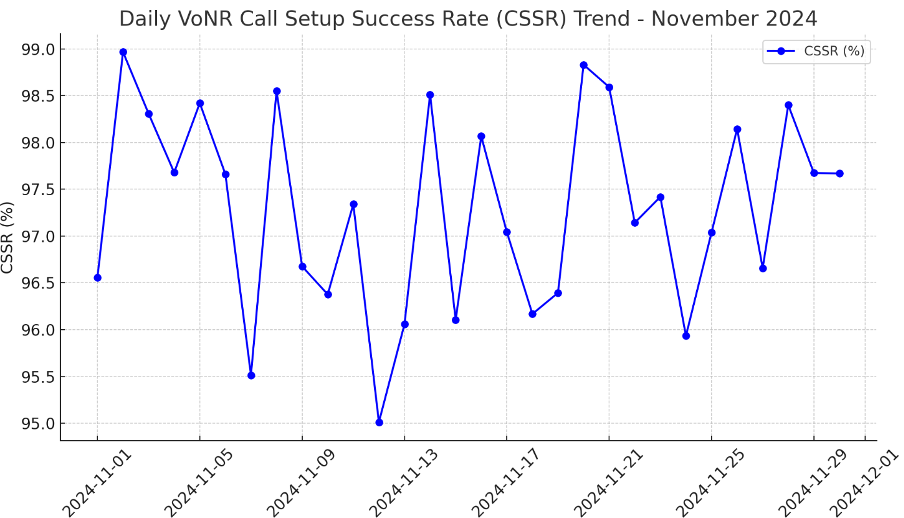
Call Drop Rate (CDR)
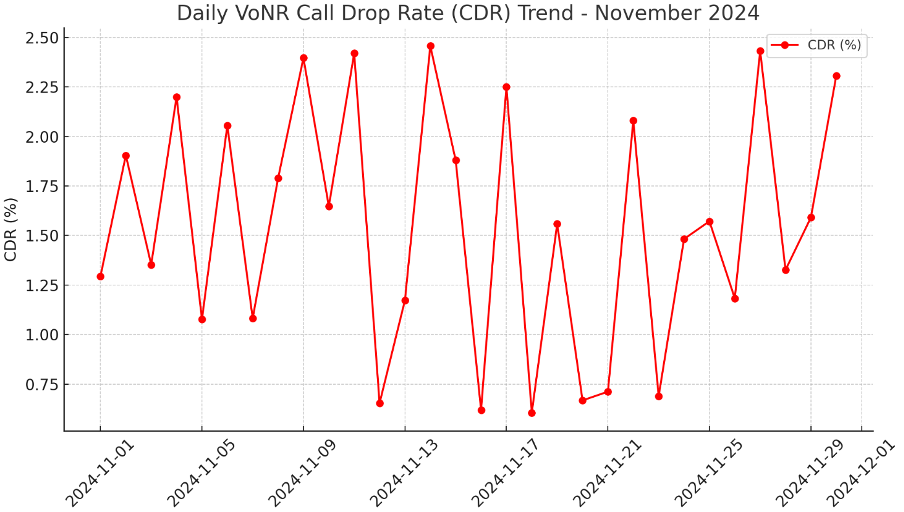
Overview
CDR quantifies the percentage of calls that are unintentionally terminated by the network.
Critique
- Insufficient for VoNR: In 5G networks, factors like rapid cell handovers and beamforming can introduce new challenges that CDR alone cannot capture.
- Does Not Address Quality: CDR focuses on call continuity but does not reflect the voice quality during the call.
Latency Metrics
Packet Loss and Jitter
Overview
Latency KPIs measure the time delays in network communication, which are crucial for real-time services like voice calls.
Critique
- Complexity in Measurement: In 5G networks, latency can be affected by various factors, including network slicing and edge computing, complicating its measurement.
- Interdependency: Latency interacts with other KPIs like jitter and packet loss, requiring a more holistic approach to assessment.
Overview
Packet loss refers to data packets failing to reach their destination, while jitter measures the variability in packet arrival times.
Critique
- New Challenges in 5G: High-frequency bands used in 5G (e.g., mmWave) are more susceptible to environmental factors, increasing packet loss and jitter.
- Impact on Voice Quality: Traditional KPIs may not fully capture how packet loss and jitter affect the advanced codecs used in VoNR.
Limitations of Current KPIs in VoNR
Inadequate Reflection of User Experience
Current KPIs often fail to provide a comprehensive picture of the user experience in VoNR services. For instance, a call may be successfully established (high CSSR) but suffer from poor voice quality due to high latency or packet loss.
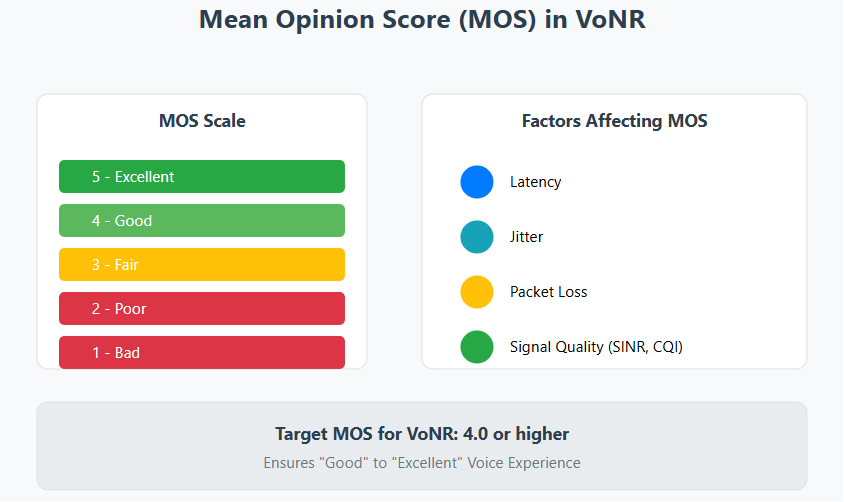
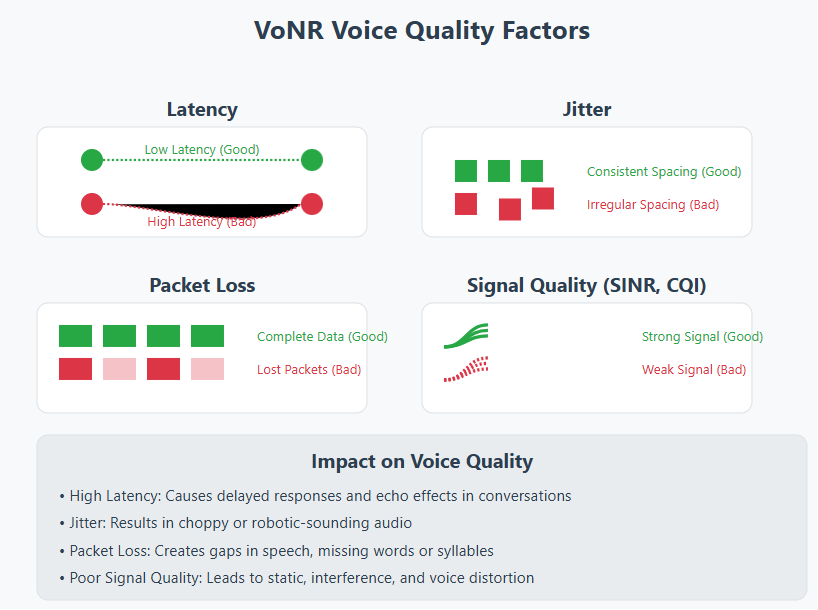
Lack of Real-Time Analytics
The dynamic nature of 5G networks requires real-time monitoring and analytics. Traditional KPIs, which may be collected and analyzed over longer periods, might not suffice for immediate optimization needs.
Insufficient Consideration of Network Slicing
5G introduces network slicing, allowing multiple virtual networks to operate on a shared physical infrastructure. Existing KPIs do not account for the performance variations across different slices.
Advanced Optimization Techniques for VoNR
To overcome the limitations of current KPIs and enhance VoNR services, network operators need to adopt advanced optimization techniques.
Implementation of Enhanced KPIs
Quality of Experience (QoE) Metrics
- Holistic Assessment: QoE metrics encompass user perceptions, combining traditional KPIs with factors like device performance and application behavior.
- Adaptive Measurement: QoE can adjust to different service types, providing more relevant insights for VoNR.
Real-Time Monitoring Tools
- AI and Machine Learning: Leveraging AI for predictive analytics can help anticipate network issues before they impact users.
- Edge Analytics: Performing data analysis at the network edge reduces latency and provides faster insights.
Network Slicing Optimization
- Dynamic Resource Allocation: Adjusting resources allocated to different network slices in real-time based on demand can enhance VoNR performance.
- Slice-Specific KPIs: Developing KPIs tailored to each network slice can provide more accurate performance assessments.
Advanced Codec Utilization
- Adaptive Codecs: Implementing codecs that can adjust to network conditions helps maintain voice quality despite fluctuations.
- High-Efficiency Codecs: Utilizing codecs designed for 5G, such as Enhanced Voice Services (EVS), can improve MOS scores.
Beamforming and Massive MIMO
- Improved Signal Quality: Beamforming directs signals towards specific users, enhancing signal strength and reducing interference.
- Capacity Enhancement: Massive MIMO increases network capacity, supporting more simultaneous VoNR calls with better quality.
Edge Computing Integration
- Reduced Latency: Processing data closer to the user minimizes latency, which is critical for voice services.
- Enhanced Reliability: Edge computing can provide localized processing, reducing dependency on the core network.
AI-Driven Network Management
- Predictive Maintenance: AI algorithms can predict potential failures and optimize network parameters proactively.
- Traffic Forecasting: Anticipating traffic patterns allows for better resource allocation, reducing congestion and improving QoE.
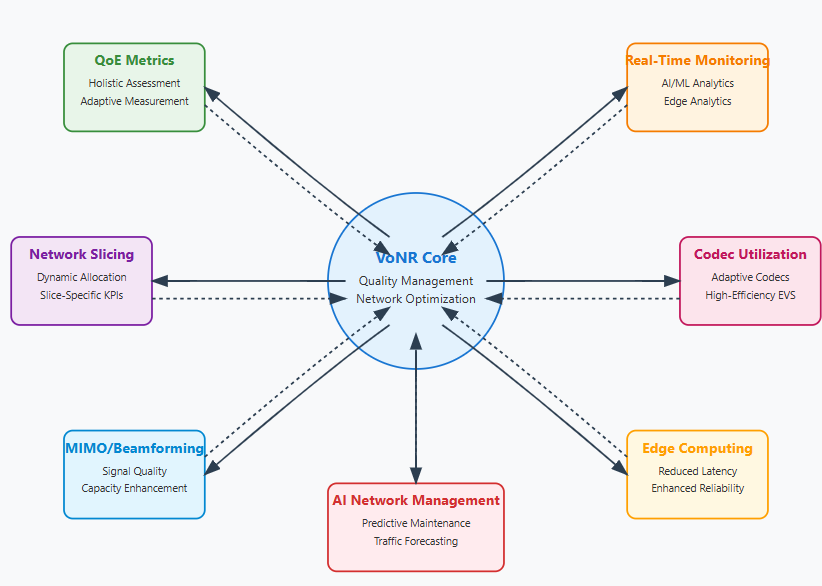
Case Studies: Real-World Implementations
Operator A: Enhancing VoNR with AI
Operator A implemented AI-driven analytics to monitor network performance in real-time. By focusing on QoE metrics, they achieved a 15% improvement in MOS scores and reduced call drop rates by 10%.
Operator B: Network Slicing Optimization
Operator B developed slice-specific KPIs and dynamically allocated resources based on real-time demand. This approach led to a 20% increase in network efficiency and improved voice quality during peak hours.
Challenges in Optimizing VoNR
Technical Complexity
- Integration Issues: Incorporating new technologies like AI and edge computing requires significant changes to existing infrastructure.
- Interoperability: Ensuring compatibility between different network components and vendors can be challenging.
Cost Implications
- Investment in Infrastructure: Upgrading to support advanced optimization techniques involves substantial capital expenditure.
- Operational Expenses: Ongoing costs for maintenance and software updates can strain resources.
Regulatory and Security Concerns
- Data Privacy: Real-time analytics and AI involve handling vast amounts of user data, raising privacy concerns.
- Compliance: Operators must navigate complex regulations governing telecommunications and data management.
Future Outlook
Standardization of New KPIs
- Industry Collaboration: Establishing standardized KPIs that reflect the nuances of VoNR will facilitate better benchmarking and optimization.
- Regulatory Support: Engagement with regulatory bodies to align new KPIs with compliance requirements.
Evolution of Optimization Techniques
- Continuous Innovation: As technology evolves, new optimization methods will emerge, necessitating ongoing adaptation by network operators.
- User-Centric Approaches: Emphasizing the end-user experience will drive the development of more effective KPIs and optimization strategies.
Conclusion
The transition to VoNR in 5G networks presents both opportunities and challenges for network operators. While VoNR has the potential to deliver superior voice quality and network efficiency, realizing these benefits hinges on the effective measurement and optimization of network performance.
Traditional KPIs like MOS, CSSR, and CDR, while still relevant, have limitations that must be addressed in the context of 5G’s advanced capabilities. By adopting enhanced KPIs that offer a more holistic view of the user experience and leveraging advanced optimization techniques such as AI-driven analytics, network slicing optimization, and edge computing, operators can significantly improve VoNR services.
The journey towards optimizing VoNR is complex, involving technical, financial, and regulatory hurdles. However, with strategic investments and a focus on innovation, network operators can overcome these challenges, delivering exceptional voice services that meet and exceed user expectations in the 5G era.
Knowledge of eMBB, URLCC, MMTC.
5G RAN ARCHITECTURE, NR NSA mobility, Massive Mimo, Beamforming, 5G Frame structure, Ultra lean design, 5G QOS compare with LTE, Ericsson & Huawei RAN system for 5G. 5G planning Knowledge.
RF Planning & Optimization in LTE & VOLTE Network
Planning new LTE Macro & IBS sites.
• Cluster-based RF optimization
• Preparation of CDD for LTE network. PCI & RSN planning.
• Analysis of LTE Radio KPIs, investigation, and improvement of network quality problems.
• Implementation of new features and tuning LTE radio network parameters.
• LTE Cell planning, coverage predictions, traffic dimensioning, interference analysis, optimization of the Radio Access Networks in accordance with TRA.
• Forecasts and studies to determine future Radio Base Station and network capacity needs.
• Optimisation of newly integrated LTE sites and expansions, and focus areas.
• Technical investigations of the LTE Radio Access Network; accessibility, capacity and retain ability studies.
• Getting LTE Sites accepted from the customer RF planning team.

